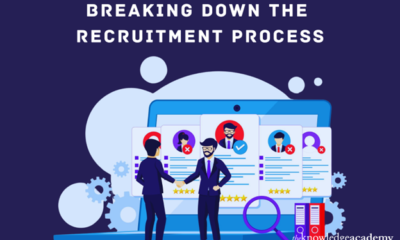Business
The Shocking FintechZoom CRM Stock Decline No One Expected

Introduction
The stock market can be unpredictable, but sometimes, the level of shock can go beyond expectations. Recently, FintechZoom CRM stock has left investors stunned as it took a steep decline that few saw coming. What led to this shocking drop? In this article, we’ll break down the reasons behind the sudden downfall, how it affected investors, and what might be on the horizon for CRM stock in the future. We’ll also explore the factors influencing this unexpected turn of events and offer some insights for those interested in the fintechZoom CRM stock market.
Table of Contents
What is CRM?
Customer Relationship Management, or CRM, refers to the tools and strategies businesses use to manage their interactions with customers. This technology helps businesses organize, automate, and synchronize various customer-facing functions, such as sales, marketing, and customer service. Companies heavily rely on CRM to maintain good relationships with their customers, making it an essential tool in today’s business world.
Why CRM Stocks Are Generally Attractive
CRM stocks have been highly attractive to investors due to the rising demand for software solutions that enhance customer interactions. As companies increasingly depend on data to improve their customer experiences, CRM solutions continue to grow in relevance, pushing up the stock value for companies involved in the CRM market.
FintechZoom CRM Stock Role
FintechZoom, though best known for its coverage of fintech news, has also become a significant player in the CRM market. The company has long been praised for its ability to adapt and innovate in the competitive CRM sector, and its CRM stock has been a popular choice for investors seeking growth in the tech space.
Past Success of FintechZoom CRM Stock
Until recently, FintechZoom CRM stock was seen as a reliable investment. The company’s innovative solutions, coupled with its steady growth, made it a strong contender in the CRM space. Investors were confident in its continued upward trajectory, which made the recent decline all the more surprising.
The Sudden Decline: What Happened?
The recent FintechZoom CRM stock decline caught everyone off guard. Over the course of a few weeks, the stock lost a significant portion of its value, leaving investors in disbelief. The drop wasn’t gradual—it was a sudden plunge, which led many to question what had gone wrong.
Market Reactions
The immediate reaction from the market was panic. Investors, unsure of the company’s future, began selling off their shares. This led to a further drop in the stock price as panic selling set in.
Analysts’ Reactions to the News
Financial analysts were quick to offer their opinions, with some suggesting that the stock had been overvalued for some time. Others believed that the company’s fundamentals were still strong, but external factors had caused a temporary setback.
Why No One Expected the Drop
Historical Performance of the Stock
Historically, FintechZoom CRM stock had been a consistent performer, which made the sudden drop even more puzzling. For years, the company had enjoyed steady growth, leading many investors to believe that it was a low-risk option.
Underlying Causes of the Decline
There were several factors behind the decline, including poor financial performance in the last quarter and increased competition from other CRM providers. The combination of these factors created a perfect storm that led to the stock’s sharp drop.
External Factors
External market conditions, such as rising interest rates and global economic uncertainty, also played a role in the decline. These broader financial issues affected the entire tech sector, but FintechZoom’s CRM stock was hit particularly hard.
Impact on Investors
For those who had invested heavily in FintechZoom, the decline came as a major blow. Many saw significant losses in their portfolios, and the drop created uncertainty about the future of their investments.
Short-term and Long-term Effects
In the short term, the decline has hurt confidence in the company. Long-term, the impact will depend on how well FintechZoom can recover and adapt to the changing CRM landscape.
Lessons for Investors
Investors can learn several valuable lessons from this event, primarily the importance of diversification and staying informed about market conditions.
Key Takeaways
It’s important to remember that even strong-performing stocks can experience sudden declines. Diversifying your portfolio and staying updated on market trends can help you avoid major losses.
The Role of Market Volatility
Tech stocks, especially in sectors like fintech and CRM, are particularly vulnerable to volatility. Investors should be aware of the risks that come with investing in this space.
Should You Hold, Sell, or Buy More?
Depending on your risk tolerance, holding or even buying more stock during the dip could be a smart move. However, if you’re risk-averse, selling may provide some peace of mind.
Future of FintechZoom CRM Stock
The future of FintechZoom’s CRM stock is uncertain, but there are reasons to be cautiously optimistic. The company’s strong history and innovative approach could help it recover from this setback.
Key Indicators to Watch
Investors should keep an eye on the company’s upcoming earnings reports and any strategic changes in management. These will be key indicators of whether the stock can regain its footing.
Conclusion
The decline of FintechZoom CRM stock was shocking, but it serves as a reminder of the unpredictability of the stock market. While the drop was significant, it’s not the end of the road for FintechZoom. With the right strategies, the company could recover and once again be a strong player in the CRM space. Investors, however, should remain cautious and stay informed about any developments.
Business
Real Estate Agent Offenbach

When looking for a Immobilienmakler Offenbach it’s essential to find someone who understands both the city’s evolving market and your personal property goals. Offenbach, once considered a quieter neighbor to Frankfurt, is now a booming real estate hotspot in the Rhine-Main region. With its growing population, affordable housing options, and rich cultural scene, more buyers, sellers, and investors are turning their attention to Offenbach. Whether you’re planning to purchase your first home, invest in rental properties, or sell your apartment, choosing the right agent can make all the difference.
Table of Contents
Why Offenbach is an Emerging Property Hub
Located just across the Main River from Frankfurt, Offenbach offers the perfect blend of urban convenience and residential charm. In recent years, Offenbach has undergone significant urban renewal projects, attracting young professionals, families, and creative industries. The city’s proximity to Frankfurt makes it ideal for commuters, while property prices in Offenbach remain more accessible. This affordability combined with ongoing development makes it a smart investment choice. A skilled real estate agent in Offenbach will help you navigate this growing market and find the best opportunities.
The Role of a Real Estate Agent in Offenbach
A real estate agent does much more than show properties. In a competitive market like Offenbach, a local agent acts as your advisor, negotiator, and guide through the entire process. They provide insights into market trends, pricing, neighborhood growth, and legal requirements. Whether you are a buyer or seller, a good agent ensures smooth communication, accurate paperwork, and fair negotiations. In Offenbach’s fast-evolving districts, having someone with up-to-date knowledge and strong connections is a major advantage.
What to Look for in an Offenbach Agent
Choosing the right Offenbach real estate agent requires more than browsing websites. Look for agents who specialize in your specific needs—residential, commercial, investment, or rental. Check for licenses, client testimonials, years of experience, and knowledge of neighborhoods like Bieber, Bürgel, or Kaiserlei. The best agents are transparent, patient, and proactive. They should listen to your needs, offer honest assessments, and not push you into decisions. Strong local expertise is vital, especially as new developments reshape the city’s housing landscape.
Neighborhood Insights: Where to Buy or Sell in Offenbach
Offenbach boasts diverse neighborhoods that appeal to different types of buyers. Bieber is ideal for families due to its schools and quiet streets. Kaiserlei, located near the border with Frankfurt, is a prime location for professionals and investors due to its office developments and excellent transport links. Lauterborn and Tempelsee offer a mix of modern housing and green spaces, making them popular among young couples. A local real estate agent will help you identify which areas match your lifestyle or investment goals—and guide you to the best listings.
Services Offered by Real Estate Agents in Offenbach
Top agents in Offenbach provide a range of services to streamline the buying or selling process. These include property valuations, professional photography, virtual tours, targeted marketing, staging consultations, and open house coordination. For sellers, they create compelling listings that attract serious buyers. For buyers, they offer customized searches, arrange viewings, assist with financing, and manage negotiations. Some agents also offer multilingual services—especially useful in an international city like Offenbach where many buyers come from abroad.
The Importance of Local Knowledge
Offenbach’s real estate market is dynamic and still evolving, especially with upcoming construction projects, new business hubs, and rising rental demand. A real estate agent with deep local knowledge can offer insights that online platforms or out-of-town agents simply can’t. For example, understanding future infrastructure plans, school zone changes, or market trends in a particular district can help you make smarter decisions. Whether buying or selling, insider knowledge translates into better deals and faster transactions.
Real Estate for Expats and International Buyers
Offenbach’s proximity to Frankfurt and its growing global community make it increasingly attractive to international buyers. For expats, navigating German property laws and processes can be confusing. A real estate agent who speaks English and understands international client needs can be a huge help. From explaining contract terms to guiding you through mortgage approvals and notary appointments, these agents simplify the experience. Many also assist with rental investments, helping foreign buyers find tenants and manage properties remotely.
Top-Rated Agencies and Independent Agents in Offenbach
There are several reputable agencies and independent realtors in Offenbach. Firms like Engel & Völkers, Von Poll Immobilien, and Immobilienservice RheinMain have strong presences in the area and offer professional services backed by experience. At the same time, many independent agents also offer personalized service, with flexible hours and in-depth local knowledge. When choosing, compare client reviews, recent sales, and their familiarity with the neighborhood you’re interested in. A good rapport and clear communication are just as important as credentials.
Final Thoughts: Partnering with the Right Agent
Offenbach’s real estate market offers immense potential for buyers, sellers, and investors alike. But success in this competitive environment depends heavily on working with the Immobilienmakler Offenbach. The ideal agent will not only guide you through the practical steps but also offer valuable insight that leads to smarter decisions. Whether you’re drawn to Offenbach for its affordability, location, or growth potential, a trusted agent will help you make the most of your real estate journey. Take the time to research, ask questions, and choose someone who understands your goals—and Offenbach’s promising future.
Business
Education Loan Explained: Eligibility and Advantages

Quality higher education can lay the foundation for a successful and fulfilling career. However, the rising cost of education often becomes a challenge for many students and their families. In such a case, opting for an education loan can be a suitable option. An education loan helps students cover their financial requirements without putting pressure on their families. There are many banks and Non-Banking Financial Companies (NBFCs) that provide education loans at competitive rates. This article explains what education loans are, their advantages, eligibility criteria, and more.
Table of Contents
What is an Education Loan?
A loan for education is a type of financial aid offered by banks or financial institutions to help students pay for their higher education. This loan generally covers all the expenses such as tuition fees, accommodation, books, travel (if studying abroad), and other related costs. These loans can be used for studying in India or abroad. Some education loans also offer flexible repayment options and allow students to begin repayment after completing their course.
Eligibility Criteria for an Education Loan
The eligibility for an education loan may vary from lender to lender, but the common requirements include:
1. Nationality
To qualify, an applicant must be an Indian citizen. It’s important to note that loan options, interest rates, and repayment terms can vary across banks and financial institutions, so comparing lenders is essential before applying.
2. Academic Qualification
The student must have secured admission to a recognised institution in India or abroad through an entrance test or merit-based selection. This helps lenders ensure that the loan is given to students pursuing serious and credible courses. The institution should be accredited or approved by the relevant education authorities. Proof of admission is usually required during the loan application process.
3. Age Limit
Generally, the applicant’s age should be between 18 to 35 years at the time of applying for the loan. Some lenders may have slight variations in age criteria depending on the course or loan scheme. This age range is considered suitable as it aligns with most students pursuing higher education. In certain cases, older students may be eligible but may need to fulfil additional requirements.
4. Course and Institution
The loan is usually sanctioned for professional or technical courses like engineering, medical, management, and similar fields from recognised universities. One thing to note is that lenders prefer courses that offer strong career prospects. This makes them sure that the student will be able to repay the loan after completing his/her studies. Some lenders may also provide loans for diploma or vocational courses if they meet certain criteria.
5. Co-applicant
A co-applicant (usually a parent or guardian) is mandatory. The co-applicant’s income and credit history are considered to determine loan approval and amount. Having a reliable co-applicant increases the possibility of getting a higher loan amount and better loan terms. The co-applicant is equally responsible for repaying the loan if the student is unable to do so.
Advantages of Education Loans
Education loans offer several benefits that make them a preferred financing option for students:
1. Financial Independence
Thanks to education loans, students can attend the institution and pursue the course they want, without relying only on the family’s savings or selling valuable assets. This means they can concentrate on learning, since their needs are taken care of. With educational loans, students can choose what they want to study, regardless of how much funds they have now.
2. Affordable Repayment Options
Students can be given more time to pay back the loan, often during the duration of the course and for several months after its completion. Therefore, interest and loan payments are not required right from the beginning. You can pay back the loan in smaller instalments over an extended time.
3. Tax Benefits
Under Section 80E of the Income Tax Act, the interest paid on education loans is tax-deductible for up to 8 years. This can reduce your overall tax burden significantly. However, the benefit applies only to the interest, not the principal loan amount.
4. Covers a Wide Range of Expenses
Apart from tuition, loans may cover costs like accommodation, travel (for foreign studies), exam fees, and other educational materials. This helps students manage all education-related expenses in one place. Some loans also include funds for internships or training programs linked to the course.
5. Improves Credit Score
Timely repayment of education loans, along with managing the education loan interest rates responsibly, helps build a strong credit history. This tends to make it easier to secure other loans in the future.
Conclusion
For students aiming to get a quality higher education, education loans give them the confidence to focus on their studies rather than their budget. If students meet the eligibility criteria and decide on the proper loan, they can easily manage fees for schooling and get improvements in their credit scores, plus enjoy better tax terms and hassle-free repayment. With support from banks and NBFCs, education loans make it easier to focus on learning and building a secure future. If you plan carefully and repay on time, an education loan can support you in building your career.
Business
Comprehensive Guide to Real Estate Valuation in Frankfurt: Market Trends and Insights

Frankfurt, Germany’s financial powerhouse, is a city known for its blend of modern infrastructure, historical charm, and high economic potential. As one of the most influential financial centers in Europe, the demand for real estate valuation in Frankfurt continues to grow, making Immobilienbewertung Frankfurt in this city a crucial element for investors, homeowners, and businesses alike. Understanding the dynamics of the Frankfurt property market, along with the factors influencing property values, is essential for anyone looking to invest or engage in property transactions in the city. In this comprehensive guide, we will delve into the key elements of real estate valuation in Frankfurt, providing insights into market trends, valuation methods, and important considerations for both buyers and sellers.
Table of Contents
The Role of Real Estate Valuation in Frankfurt
Real estate valuation refers to the process of estimating the market value of a property. This assessment is vital for various stakeholders, including property buyers, sellers, investors, lenders, and government authorities. In Frankfurt, real estate valuation in Frankfurt plays a particularly significant role due to the city’s status as Germany’s economic hub and its position as a central player in the European market. Whether you are purchasing a residential property, commercial space, or land for development, understanding the nuances of valuation can help you make informed decisions and mitigate risks.
Key Factors Influencing Real Estate Valuation in Frankfurt
The valuation of real estate in Frankfurt is influenced by several key factors. Economic conditions are among the most significant, as a strong economy typically drives demand for property. Frankfurt, being home to the European Central Bank and numerous multinational corporations, benefits from a robust financial sector, resulting in continuous demand for both commercial and residential properties.
Other factors affecting property values include the location, size, and condition of the property. For example, properties located in central areas like Innenstadt, which offers proximity to financial institutions and cultural landmarks, tend to have higher valuations compared to properties in suburban neighborhoods. Similarly, the age and condition of the building, the availability of amenities, and the overall design and layout are critical considerations when determining value.
Additionally, external factors such as interest rates, government policies, and urban development projects can impact real estate prices in Frankfurt. For instance, the city has been undergoing significant development, including residential and commercial projects aimed at accommodating the growing population and workforce. These developments can influence demand and, in turn, property values.
Market Trends of Real Estate Valuation in Frankfurt
The real estate valuation in Frankfurt has seen several notable trends over the past few years. A growing demand for residential properties, particularly in the luxury and high-end segments, has been driven by an influx of expatriates and professionals working in the financial sector. This trend is reflected in the rising property prices in districts like Westend and Sachsenhausen, where modern apartments and upscale buildings are in high demand.
Another key trend is the increasing demand for sustainable and energy-efficient properties. As environmental concerns continue to rise, buyers and investors are becoming more conscious of energy consumption and sustainability. Consequently, buildings that adhere to green building standards and have energy-efficient features are being valued higher than older, less efficient properties. This shift toward sustainability has also led to greater interest in renovation projects, with many buyers opting to refurbish older properties to meet modern energy standards.
Moreover, the COVID-19 pandemic has had a profound impact on the real estate valuation in Frankfurt, as it has elsewhere. While the demand for office spaces has seen some fluctuations, residential real estate, particularly in suburban areas, has gained traction due to remote working trends. Many professionals now seek more spacious homes outside the city center, leading to increased interest in properties in neighborhoods like Bockenheim and Nordend.
Common Methods of Real Estate Valuation in Frankfurt
There are several methods employed by real estate professionals to determine the value of a property in Frankfurt. Each method considers different factors and is suited to specific types of properties.Sales Comparison Approach: This is one of the most commonly used methods in residential real estate valuation in Frankfurt. It involves comparing the property being valued with similar properties that have recently sold in the same area. The assumption is that the price of a comparable property is a good indicator of the market value of the subject property.
Income Approach: This method is primarily used for commercial properties, such as office buildings or apartment complexes. It estimates the value of the property based on the income it generates, including rental income and other revenue streams.
The income approach is particularly useful for investors looking to assess the potential return on investment.Cost Approach: The cost approach calculates the value of a property based on the cost to replace or reproduce it, minus depreciation. This method is often used for new or unique properties where there is little to no market data for comparison. It is also useful in situations where properties are in a state of disrepair and require significant renovation.
The Role of Property Appraisers in Frankfurt
Real estate appraisers play a pivotal role in the valuation process. In Frankfurt, professional property appraisers, or “Gutachter,” are typically licensed experts who use a combination of market knowledge, industry experience, and valuation methods to provide an accurate assessment of a property’s worth. These appraisers are often required for mortgage financing and property tax assessments, as their valuations are trusted by banks, lenders, and government authorities.
Property appraisers in Frankfurt are expected to adhere to rigorous standards and regulations, ensuring that their valuations are fair and objective. They consider a variety of factors, including the location, market trends, property condition, and legal aspects such as zoning and permits. For anyone looking to invest or sell property in Frankfurt, working with a qualified appraiser is highly recommended to obtain an accurate and unbiased valuation.
Navigating the Real Estate Valuation in Frankfurt Market as a Buyer
For buyers, navigating the Frankfurt real estate market can be challenging due to rising property prices and increased demand. However, understanding the factors influencing property values and staying informed about market trends can help buyers make sound decisions.
One important tip for prospective buyers is to focus on the long-term potential of a property. Given Frankfurt’s status as a major financial center, investing in property located in key districts or areas undergoing redevelopment can yield significant returns. Additionally, buyers should consider the potential for rental income, especially if purchasing a property for investment purposes. Properties in proximity to public transportation, business hubs, and cultural landmarks tend to have higher rental demand.
Selling Property in Frankfurt: Maximizing Value
For sellers, understanding the valuation process is essential for maximizing the sale price of a property. The key to achieving a higher sale price lies in presenting the property in its best light. This can be done through renovations, staging, and ensuring that the property is well-maintained. Sellers should also work with real estate agents and appraisers to set an appropriate asking price based on market conditions and comparable sales.
Timing also plays a significant role in selling property in Frankfurt. Selling during a seller’s market, when demand outstrips supply, can lead to higher sale prices. However, sellers should be aware of economic fluctuations, as changes in interest rates or economic uncertainty can affect buyer sentiment and demand.
The Impact of Government Policies and Regulations
Government policies and regulations also play a critical role in real estate valuation in Frankfurt. The city is subject to Germany’s strict property laws, which aim to ensure fair and transparent transactions. These regulations cover everything from zoning and land use to property taxes and rental laws. In recent years, Germany has introduced measures to combat rising property prices and prevent excessive rent increases, which can affect the valuation of both residential and commercial properties.
Frankfurt is also part of the broader European Union market, and any regulatory changes at the EU level, such as interest rate policies or housing market regulations, can have an impact on real estate values.
Conclusion
Immobilienbewertung Frankfurt is a complex process shaped by numerous factors, including economic conditions, market trends, property characteristics, and government regulations. Understanding these dynamics is essential for anyone involved in the Frankfurt real estate market, whether you’re a buyer, seller, or investor. By staying informed about the latest trends, using appropriate valuation methods, and working with qualified professionals, you can make sound decisions that maximize your investment and navigate the ever-evolving property market in this dynamic city.
As Frankfurt continues to grow and develop, its real estate market will undoubtedly present new opportunities and challenges. With the right knowledge and approach, however, investors and property owners can capitalize on this vibrant market and make the most of their real estate ventures in Frankfurt.
NAP:
Dornbusch Immobilien
Eschersheimer Landstraße 230
60320 Frankfurt
+4991314151
-

 Games9 months ago
Games9 months agoMeerut City Satta King: Your Ultimate Guide to Winning!
-

 Blog9 months ago
Blog9 months agoThe Importance of Hiring Commercial Movers
-

 Business10 months ago
Business10 months agoDiscover Why debsllcs.org/ Is Leading in Sustainable Business Solutions
-

 Fashion11 months ago
Fashion11 months agoEssentials Clothing: Bold Statements in Minimalist Designs
-

 Tech7 months ago
Tech7 months agoWhy SEO is No Longer Just About Rankings
-

 Tech10 months ago
Tech10 months agovstechpanel.com Off-Page SEO: Boost Your Site’s Authority Now!
-

 Tech10 months ago
Tech10 months agoHow Do I Contact Hong Kong Reverse Technology Now for Solutions?
-

 Business1 year ago
Business1 year agoBreaking Down the Recruitment Process


















